Hog farming industry leads the sector in terms of number of establishments
The final results of the 2016 Annual Survey of Philippine Business and Industry (ASPBI) showed that there were 2,835 establishments which were engaged in agriculture, forestry and fishing in the formal sector of the economy.
Among industries, hog farming led the sector with 511 establishments or 18.0 percent of the total number of establishments. Chicken broiler production ranked second with 371 establishments or 13.1 percent of the total, followed by growing of sugarcane including muscovado sugar-making in the farm with 342 establishments (12.1%).
Other industries reporting more than a hundred number of establishments were as follows:
• Ocean fishing, commercial (using vessels over 3 tons), 201 establishments (7.1%)
• Growing of banana, cavendish, 189 establishments (6.7%)
• Contract animal growing services on a fee basis, 152 establishments (5.4%)
• Chicken egg production, 131 establishments (4.6%)
• Chicken production, layer, 114 establishments (4.0%)
Figure 1 displays the percentage distribution of all Agriculture, Forestry and Fishing establishments by industry sub-class in 2016.
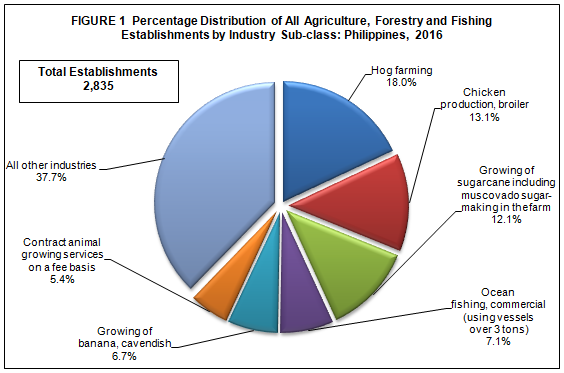
Growing of cavendish banana industry generates the highest employment
Total employment generated for all agriculture, forestry and fishing establishments reached 165,387 in 2016. Of the total workforce, 163,142 workers or 98.6 percent were paid employees while the remaining 1.4 percent were working owners and unpaid workers.
At the industry level, growing of cavendish banana had the highest number of employees with 47,591 or 28.8 percent of the total. Growing of sugarcane including muscovado sugar-making in the farm ranked second with 33,330 workers or 20.2 percent of the total. Commercial ocean fishing (using vessels over 3 tons) came next with 14,102 workers or 8.5 percent share.
Figure 2 shows the distribution of employment for all Agriculture, Forestry and Fishing establishments by industry sub-class in 2016.
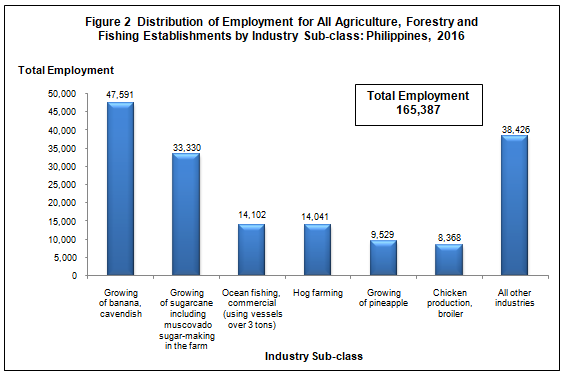
Growing of paddy rice for seed purposes industry pays the highest average annual compensation
Total compensation paid by the sector to its employees in 2016 amounted to PHP27.3 billion, which translatestoan average annual compensation of PHP167,448 per paid employee.
By industry, growing of cavendish banana paid the highest compensation of PHP12.6 billion, comprising almost half (46.2%) of the total. Growing of sugarcane including muscovado sugar-making in the farm placed second with PHP2.3 billion (8.6%). Commercial ocean fishing (using vessels over 3 tons) activities ranked third with PHP1.7 billion (6.3%).
Meanwhile, growing of paddy rice for seed purposes industry paid the highest average annual compensation amounting to PHP546,396 per paid employee. This was followed by growing of paddy rice in lowland irrigated farm with PHP439,398 average annual pay. Chemical and mechanical weed control, disease and pest control services came third with average annual pay of PHP413,691 per paid employee.
Completing the top six industries in terms of average annual compensation were as follows:
• Apiary; raising of semi-domesticated or wild animals; game propagation and breeding activities, PHP332,157 per paid employee
• Growing of banana, cavendish, PHP265,542 per paid employee
• Growing of corn, except young corn (vegetable), PHP249,138 per paid employee
Figure 3 shows the average annual compensation of paid employees for all Agriculture, Forestry and Fishing establishments by industry sub-class in 2016.
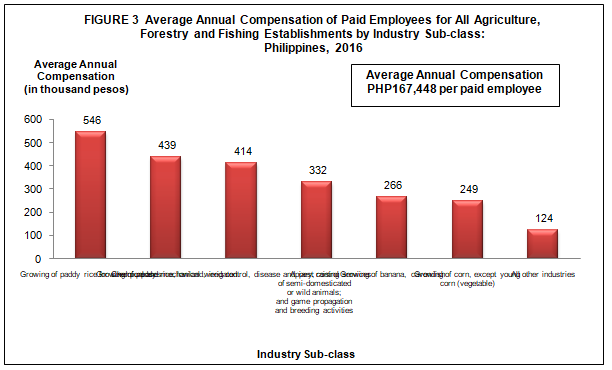
Growing of cavendish banana industry generates highest value of output
Total value of output generated by all agriculture, forestry and fishing establishments reached PHP146.4 billion in 2016.
Industry-wise, growing of cavendish banana contributed the highest value of output of PHP44.0 billion or 30.0 percent. Hog farming and growing of pineapple placed second and third with output values of PHP23.4 billion (16.0%) and PHP13.7 billion (9.4%), respectively.
Figure 4 illustrates the percentage distribution of value of output for all Agriculture, Forestry and Fishing establishments by industry sub-class in 2016.
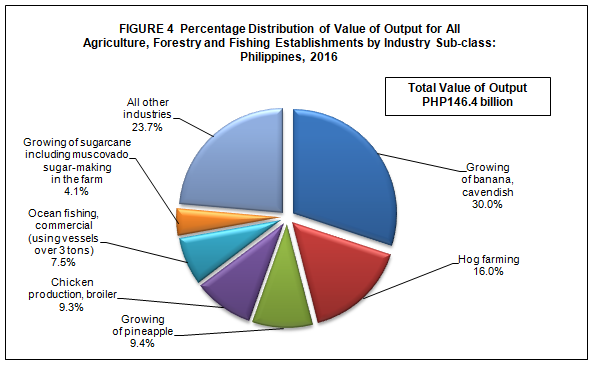
Growing of cavendish banana industry incurs the highest expense
In 2016, total expense incurred by all establishments in the sector amounted to PHP141.2 billion.
Among industries, growing of cavendish banana spent the highest, amounting to PHP44.2 billion or 31.3 percent of the total. Hog farming ranked second with total expense amounting to PHP21.7 billion (15.3%), followed by chicken broiler production with PHP13.0 billion (9.2%).
Income per peso expense ratio stands at 1.06
The sector generated an income per peso expense ratio of 1.06 in 2016. This means that for every peso spent, a corresponding income of PHP1.06 was generated.
At the industry level, growing of corn, except young corn (vegetable) recorded the highest income per peso expense ratio of 1.56. This was followed by growing of coconut, including copra-making, tuba gathering and coco-shell charcoal making in the farm with an income per peso expense ratio of 1.52.
Completing the top 10 industries in terms of income per peso expense ratio were the following:
• Preparation of crops for primary markets, i.e. cleaning, trimming, grading, disinfecting, threshing, grading, bailing and related services, 1.34
• Growing of coffee, 1.27
• Growing of timber forest species (e.g. gemelina, eucalyptus, etc.), planting, replanting, transplanting, thinning and conserving of forest and timber tracts, 1.26
• Raising of poultry (except chicken), n.e.c., 1.25
• Growing of paddy rice, lowland, irrigated,1.23
• Chemical and mechanical weed control, disease and pest control services, 1.23
• Growing of pineapple, 1.23
• Growing of mango, 1.21
Value added amounts to PHP44.6 billion in 2016
Total value added produced by all the sector’s establishments in 2016 was estimated at PHP44.6 billion.
Among industry sub-classes, growing of cavendish banana generated the highest value added amounting to PHP15.8 billion or 35.5 percent of the total. Growing of pineapple came second with PHP4.6 billion (10.3%), followed by hog farming with PHP4.5 billion (10.1%).
Growing of corn, except young corn (vegetable) industry posts the highest labor productivity
Labor productivity, which is a ratio of value added to employment, was recorded at PHP269, 526 per worker in 2016.
Growing of corn, except young corn (vegetable) recorded a labor productivity of PHP1.8 million per worker, the highest among industries. This was followed by growing of paddy rice in lowland, irrigated farm with PHP1.7 million per worker. Growing of paddy rice for seed purposes placed third with PHP1.3 million per worker.
Other leading industries in terms of labor productivity were the following:
• Chemical and mechanical weed control, disease and pest control services, PHP994,811 per worker
• Apiary; raising of semi-domesticated or wild animals; and game propagation and breeding activities, PHP939,425 per worker
• Growing of coffee, PHP801,667 per worker
• Growing of other tropical fruits, e.g. jackfruit, guavas, etc., PHP572,166 per worker
• Growing of pineapple, PHP481,046 per worker
Figure 5 displays the labor productivity for all Agriculture, Forestry and Fishing establishments by industry sub-classin 2016.
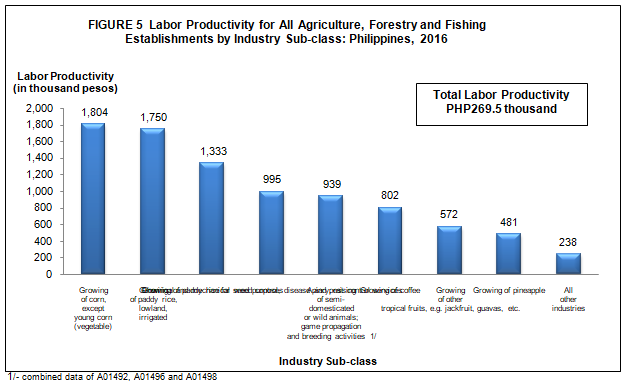
Gross additions to tangible fixed assets reaches PHP9.1 billion
Gross addition to tangible fixed assets acquired by all establishments of the sector was valued at PHP9.1 billion in 2016.
Among industries, hog farming contributed the highest gross addition to tangible fixed assets at PHP2.9 billion or 31.6 percent of the total. This was followed by growing of cavendish banana with PHP2.4 billion or 26.1 percent of the total. Commercial ocean fishing (using vessels over 3 tons) ranked third with PHP946 thousand or 10.4 percent of the total.
Total subsidy amounts to PHP2.0 billion in 2016
Subsidy granted by the government to support the business operation of all establishments of the sector in 2016 amounted to PHP2.0 billion.
In 2016, only eight industries received government subsidy, in which, services to establish crops, promote their growth and protect them from pests and diseases, n.e.c. had the highest subsidy worth PHP1.3 billion or 62.9 percent of the total. This was followed by growing of coconut, including copra-making, tuba gathering and coco-shell charcoal making in the farm receiving a subsidy of PHP4.0 million or less than one percent share of the total.
(Sgd.) ROSALINDA P. BAUTISTA
(Director II)
Officer-in-Charge
Sectoral Statistics Office
TECHNICAL NOTES
Introduction
This Special Release presents the final results of the 2016 Annual Survey of Philippine Business and Industry (ASPBI) for all Agriculture, Forestry and Fishing (Sector A) establishments.
The 2016 ASPBI is one of the designated statistical activities of the Philippine Statistics Authority (PSA). Data collected from the survey provide information on the levels, structure, performance and trends of economic activities of the formal sector in the entire country for the year 2016.
The survey was conducted nationwide in 2017 with the year 2016 as the reference period of data, except for employment which is as of November 15, 2016.
Establishment Data Management System (EDMS) was still utilized in the decentralized processing of 2016 ASPBI questionnaires in the province as well as in the online accomplishment of questionnaire through PSA website.
Data are presented at the national level andsub-class or 5-digit 2009 Philippine Standard Industrial Classification (PSIC) level.
Legal Authority
The conduct of the 2016 ASPBI is authorized under Republic Act No. 10625 known as the Philippine Statistical Act of 2013 - Reorganizing and strengthening of the Philippine Statistical System (PSS), its agencies and instrumentalities.
Scope and Coverage
The 2016 ASPBI covered establishments engaged in 18 economic sectors classified under the 2009 PSIC, namely:
Agriculture, Forestry, and Fishing (A)
Mining and Quarrying (B)
Manufacturing (C)
Electricity, Gas, Steam, and Air Conditioning Supply (D)
Water Supply; Sewerage, Waste Management and Remediation Activities (E)
Construction (F)
Wholesale and Retail Trade; Repair of Motor Vehicles and Motorcycles (G)
Transportation and Storage (H)
Accommodation and Food Service Activities (I)
Information and Communication (J)
Financial and Insurance Activities (K)
Real Estate Activities (L)
Professional, Scientific and Technical Activities (M)
Administrative and Support Service Activities (N)
Education (P)
Human Health and Social Work Activities (Q)
Arts, Entertainment, and Recreation (R)
Other Service Activities (S)
The following sections of the 2009 PSIC are excluded from the scope of this survey and all other establishment-based surveys of PSA:
- Public Administration and Defense; Compulsory Social Security (Section O)
- Activities of Households as Employers; Undifferentiated Goods and Services Producing Activities of Households for Own Use (Section T)
- Activities ofExtra-territorial Organization and Bodies (Section U)
The survey was confined to the formal sector of the economy, which consists of the following:
- Corporations and partnership
- Cooperatives and foundations
- Single proprietorship with employment of 10 and over
- Single proprietorships with branches
Hence, the 2016 ASPBI covered only the following economic units:
All establishments with total employment of 10 and over; and
All establishments with total employment of less than 10, except those with Legal Organization = 1 (Single proprietorship) and Economic Organization = 1 (Single establishments), that are engaged in economic activities described according to the 2009 PSIC.
Frame of Establishments
The frame for the 2016 ASPBI was extracted from the 2016 List of Establishments (LE). The estimated number of establishments in operation in the country in 2016 totaled to 902,213. About 294,494 establishments (32.6% of the total establishments) belong to the formal sector of which 255,403 (86.7%) comprised the establishment frame. This frame was used to draw the sample establishments for the survey.
Unit of Enumeration
The unit of enumeration for the 2016 ASPBI is the establishment. An establishment is defined as an economic unit under a single ownership or control which engages in one or predominantly one kind of activity at a single fixed location.
Classification of Establishments
An establishment is categorized by its economic organization, legal organization, industrial classification, employment size, and geographic location.
Economic Organization refers to the organizational structure or role of the establishment in the organization. An establishment may be single establishment, branch, establishment and main office with branches elsewhere, main office only, and ancillary unit other than main office.
Legal Organization refers to the legal form of the economic entity which owns the establishment. An establishment may be single proprietorship, partnership, government corporation, stock corporation, non-stock corporation, and cooperative.
Industrial classification of an economic unit was determined by the activity from which it derives its major income or revenue. The 2009 PSIC was utilized to classify economic units according to their economic activities.
Size of an establishmentis determined by its total employment (TE) as of a specific date. Total employment (TE) refers to the total number of persons who work in or for the establishment.
This includes paid employees, working owners, unpaid workers and all employees who work full-time or part-time including seasonal workers.
Included also are persons on short term leave such as those on sick, vacation or annual leaves and on strike.
Geographic Classification refers to the classification by geographic area using the Philippine Standard Geographic Code (PSGC) classification. The PSGC contains the latest updates on the official number of regions, provinces, cities, municipalities, and barangays in the Philippines. The PSGC as of December 31, 2016 was used for the 2016 ASPBI.
Sampling Design
The 2016 ASPBI used stratified systematic sampling with 5-digit PSIC serving as first stratification variable and employment size as the second stratification variable.
Estimation Procedure
Non-Certainty Stratum (strata of TE 20 to 49 and TE 50 to 99)
The estimate of the total of a characteristic ![]() for the non-certainty employment strata in an industry domain in each region,
for the non-certainty employment strata in an industry domain in each region,

where:
s = denotes the non-certainty employment strata in TE of 20 to 99
p = 1, 2,..., 17 regions (geographic domains)
xspj = value of the jth establishment in the non-certainty employment strata in TE of 20 to 99 for an industry domain in each region
j = 1, 2, 3,…, nsp establishments
Wspj = weight of the jth establishment in the non-certainty employment strata in TE of 20 to 99 for an industry domain in each region

where:
Nsp = total number of establishments in the non-certainty employment strata in TE of 20 to 99 for an industry domain in each region
nsp = number of sample establishments in the non-certainty employment strata in TE of 20 to 99 for an industry domain in each region
- Certainty Stratum (TE 100 and over)
The value of the total of a characteristic (Xcp) for the certainty employment stratum in an industry domain in each region,

where:
c = denotes the certainty employment strata of TE 100 and over
p = 1, 2,..., 17 regions (geographic domains)
xcpj = value of the jth establishment in the certainty employment strata in TE 100 and over in an industry domain within each region
j = 1, 2, 3, …, mcp establishments
mcp = number of establishments in the certainty employment strata in TE 100 and over in an industry domain within each region
- Total Estimate for TE 20 and Over
The estimate of the total of a characteristic ![]() for the industry domain in each region (geographic domain) was obtained by aggregating the estimates for all employment strata (non-certainty and certainty) in the same industry domain,
for the industry domain in each region (geographic domain) was obtained by aggregating the estimates for all employment strata (non-certainty and certainty) in the same industry domain,

Where dp denotes the industry domains in each region.
National level estimates of the characteristics by industry domain were obtained by aggregating separately the estimates ![]() for the particular industry domain from all the regions.
for the particular industry domain from all the regions.

For Establishments with TE of Less Than 20
- Non-Certainty Stratum
The estimate of the total of a characteristic (![]() s) for the non-certainty employment stratum TE less than 20 in the sth industry domain is
s) for the non-certainty employment stratum TE less than 20 in the sth industry domain is

where:
s = denotes the non-certainty employment strata in TE of less than 20
Xsj = value of the jth establishment in non-certainty employment stratum in TE of less than 20 in Sth industry domain
j = 1,2,3..., ns establishments
Wsj = weight of the jth establishment in the non-certainty employment stratum of less than 20 in the sth industry domain

where:
Ns = total number of establishments in the non-certainty employment stratum in TE of less than 20 in the sthindustry domain
ns = number of sample establishments in the non-certainty employment stratum in TE of less than 20 in sth domain
Weight Adjustment Factor for Non-Response
To account for non-response in the non-certainty strata, the adjustment factor (n/n’) was multiplied with the sampling weight (W) of each of the sampling unit. The sampling weight, defined as N/n, was recomputed as

Thus, the adjusted weight (W’sj) for employment stratum in TE 1-9 or TE 10-19 is

where:
Ns = total number of establishments in the employment stratum in TE 1-9 or TE 10-19 in the sth industry domain
n's = number of responding establishments in the employment stratum in TE 1-9 or TE 10-19 in the sth industry domain
For the non-certainty employment stratum for the selected industry domain with TE 20-99, the adjusted weight (W'spj) is

where:
Nsp = number of establisments in the non-certainty employment stratum with TE 20-99 for the selected industry domain within each geographic domain (region)
n'sp = number of responding establishments in the non-certainty employment stratum with TE 20-99 for the selected industry domain within each geographic domain (region)
Response Rate
Response rate for all Agriculture, Forestry and Fishing sector was 93.1 percent (955 out of 1,026 establishments). This included receipts of "good" questionnaires, partially accomplished questionnaires, reports of closed, moved out or out of scope establishments.
Of the total responses, 21 establishments responded online.
Reports of the remaining non-reporting establishments were taken from financial statements from Securities and Exchange Commission (SEC) and other available administrative data sources. Reports of establishments which were found to be out-of-scope, duplicate of another establishment and out of business in 2016 were not included in the generation of statistical tables.
Limitation of Data
The 2016 ASPBI covered only the formal sector of the economy.
Concepts and Definitions of Terms
Economic activity is the establishment’s source of income. If the establishment is engaged in several activities, its main economic activity is that which earns the biggest income or revenue.
Total employment is the number of persons who worked in for the establishment as of November 15, 2016.
Paid employees are all persons working in the establishment and receiving pay, as well as those working away from the establishment paid by and under the control of the establishment. Included are all employees on sick leave, paid vacation or holiday. Excluded are consultants, home workers, receiving pure commissions only, and workers on indefinite leave.
Income or Revenue refers to cash received and receivables for goods/products and by-products sold and services rendered.
Expense refers to cost incurred in an enterprise effort to generate revenue, representing the cost of doing business. This is treated on a consumed basis. It excludes cost incurred in the acquisition of income generating assets.
Compensation is the sum of salaries and wages, separation/retirement/terminal pay, gratuities, and payments made by the employer in behalf of the employees such as contribution to SSS/GSIS, ECC, PhilHealth, Pag-ibig, etc.
Salaries and wages are payments in cash or in kind to all employees, prior to deductions for employee’s contributions to SSS/GSIS, withholding tax, etc. Included are total basic pay, overtime pay and other benefits.
Value of output represents the sum of the receipts from products and by-products sold, agricultural/forestry/fishery services rendered, industrial services, and goods sold in the same condition as purchased less the cost of goods sold; and value of fixed assets produced on own account and change in inventories of finished products and work-in-progress.
Intermediate expense are expenditures incurred in the production of goods such as materials and supplies used, fuels, lubricants, oils and greases used; electricity and water purchased, agricultural/forestry/fishery and industrial services done by others.
Value added is gross output less intermediate input. Gross output for the agriculture, forestry and fishing sector is value of output non-industrial services done for others (except rent income from land). Intermediate input is intermediate expenses plus non-industrial services done by others (except rent expense for land) and all other expenses.
Gross addition to tangible fixed assets is equal to capital expenditures less sale of fixed assets, including land.
Change in inventories is equivalent to the value of inventories at the end of the year less the value of inventories at the beginning of the year.
Inventories refer to the stock of goods owned by and under the control of the establishment as of a fixed date, regardless of where the stocks are located. Valuation is at current replacement cost in purchaser prices. Replacement cost is the cost of an item in terms of its present price rather than its original cost.
Subsidies are all special grants in the form of financial assistance or tax exemption or tax privilege given by the government to aid and develop an industry.
E-commerce refers to the selling of products or services over electronic systems such as Internet Protocol-based networks and other computer networks. Electronic Data Interchange (EDI) network, or other on-line system. Excluded are orders received from telephone, facsimile and e-mails.
